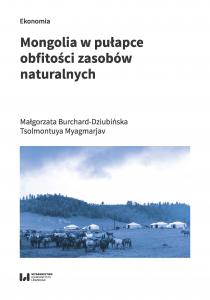-
2250
-
1072
-
1069
-
1014
-
984

Pliki do pobrania
Monografia stanowi zaproszenie do refleksji nad rolą zasobów naturalnych we współczesnym świecie. Rozważania w niej zawarte zostały osadzone w teorii ekonomii środowiska i zasobów naturalnych, a także ekonomii instytucjonalnej. Mają na celu opisanie, analizę i ocenę roli dwóch elementów, które zdeterminowały proces rozwoju Mongolii – ogromnych, nie do końca zbadanych, bogactw naturalnych tego państwa oraz instytucji określających zasady ich eksploatacji. To, kto i na jakich zasadach ma dostęp do zasobów naturalnych kraju, silnie determinuje udział w korzyściach płynących z ich pozyskiwania. Mongolia stanowi pod tym względem niezwykle interesujący przedmiot badań z uwagi na doświadczenia historyczne związane z rozwojem wyjątkowej kultury i stylu życia mongolskich koczowników, a także ze względu na obfitość zasobów kopalin o strategicznym i kluczowym znaczeniu dla nowoczesnych technologii.
Czy powstałe w okresie transformacji systemowej instytucje rzeczywiście sprzyjają trwałemu rozwojowi społeczeństwa i gospodarki Mongolii, a może wprowadziły kraj w pułapkę obfitości zasobów naturalnych? Czytelnik znajdzie odpowiedź na to pytanie w prezentowanej książce.
Publikacja jest w szczególności adresowana do odbiorców zainteresowanych problemami gospodarowania zasobami naturalnymi, wykładowców akademickich, studentów ekonomii, ochrony środowiska i stosunków międzynarodowych oraz osób, dla których gospodarka Mongolii stanowi obiekt penetracji biznesowej.
Minerals Yearbook. Mongolia, USGS, https://prd-wret.s3-us-west-2.amazonaws.com/assets/palladium/production/atoms/files/myb3-2015-mg.pdf (dostęp: 25.11.2020).
Acemoglu D., Johnson S., Robinson J.A., Reversal of Fortune: Geography and Institution in the Making of the Modern World Income Distribution, „Quarterly Journal of Economics” 2002, t. 117, nr 4, s. 1231–1294.
Anderson J.H., The Size, Origins, and Character of Mongolia’s Informal Sector during the Transition (No. 1916), World Bank Publications, Washington 1998, s. 1, 8, 13.
Annual Report 2011, Bank of Mongolia.
Annual Report 2018, Bank of Mongolia.
Atlas of Economic Complexity, red. C.A. Hidalgo, R. Hausmann et al., Massachusetts Institute of Technology, Cambridge Mass. 2011.
Auty R.M., Sustaining Development in Mineral Economies. The Resource Curse Thesis, Routledge, London–New York 1993.
Barnett H.J., Morse Ch., Scarcity and Growth. The Economics of Natural Resources Availability, Resources for the Future, Inc., The Johns Hopkins Press, Baltimore 1963.
Batjargal Z., Desertification in Mongolia, RALA Report No. 200, Agricultural Research Institute, Reykjavik 1997.
Batjargal Z., Przyroda i środowisko w Mongolii, Ministerstwo Przyrody i Środowiska, Ułan Bator 1996 (w j. mongolskim).
Batsukh N., Mongolian forest ecosystems, WWF Mongolia Programme Office, http://d2ouvy59p0dg6k.cloudfront.net/downloads/forest_ecosystems_in_mn_march04.pdf (dostęp: 4.11.2020).
Benchmark Definition of Foreign Direct Investment – Third Edition, OECD, Paris 1996.
Białecki K.P., Januszkiewicz W., Oręziak L., Leksykon handlu zagranicznego, Polskie Wydawnictwo Ekonomiczne, Warszawa 2007.
Bilans węgla, Urząd Statystyczny Mongolii, www.1212.mn (dostęp: 22.02.2019).
BP Statistical Review.
Brigham D., Emerging Commons Tragic Institutions, „Environmental Law” 2007, t. 37, s. 515–571.
Brooke J., Finding a Mother Lode in Mongolia, New York Times, 14.10.2004, https://www.nytimes.com/2004/10/14/business/worldbusiness/finding-a-motherlode-in-mongolia.html (dostęp: 12.12.2019).
Burchard-Dziubińska M., Strategiczna rola metali ziem rzadkich w gospodarce opartej na wiedzy, „Gospodarka w Praktyce i Teorii” 2014, nr 1 (34), s. 21–33.
Burchard-Dziubińska M., Myagmarjav T., Traditional Pastoralism or Mining? Conflict of Interest in Access to Natural Pastures in Mongolia and the Problem of Ecological and Environmental Justice, „Ekonomia i Środowisko” 2019, nr 4 (71), s. 56–68.
Buyanbadrakh Ch., Монгол орны лавлах, Ulaanbaatar 2012.
Campi A., Mongolia in Northeast Asia – The New Realities, „Mongolian Journal of International Affairs” 2013, t. 12, s. 46‒64.
Chaline E., 50 substancji, które zmieniły bieg historii, Oficyna Wydawnicza Alma-Press, Warszawa 2017.
The Changing Wealth of Nations Measuring Sustainable Development in the New Millennium, World Bank, 2011.
Chatty D., The Bedouin in Contemporary Syria: The Persistence of Tribal Authority and Control, „Middle East Journal” 2010, t. 64, nr 1, s. 29–49.
COM (2017) 490 final, Komunikat Komisji do Parlamentu Europejskiego, Rady, Europejskiego Komitetu Ekonomiczno-Społecznego i Komitetu Regionów w sprawie wykazu surowców krytycznych dla UE 2017, Bruksela, dnia 13.09.2017 r.
Corden W.M., Booming Sector and Dutch Disease Economics: Survey and Consolidation, „Oxford Economic Papers” 1984 (November), t. 36, nr 3, s. 359–380.
Corruption Risk Assessment in Mining Sector in Mongolia, Independent Research Institute of Mongolia NGO, Independent Authority Against Corruption of Mongolia, United Nations Development Programme, Ulaanbataar 2016.
Daly J.C.K., Mongolia’s Rare Earth Reserves Draw Foreign Investor Interest, Central Asia-Caucasus Institute Analyst, 2011.
Dauvin M., Guerreiro D., The Paradox of Plenty: A Meta-Analysis, „World Development” 2019 (June), t. 94, s. 212–231.
Dobson A., Justice and the Environment. Conceptions of Environmental Sustainability and Theories of Distributive Justice, Oxford University Press, Oxford 1998.
Doing Business 2019, The World Bank, https://www.doingbusiness.org/en/reports/global-reports/doing-business-2019 (dostęp: 5.01.2020).
The Dutch Disease, „The Economist” 26.11.1977, s. 82–83.
Economic Policy and Competitiveness, Research Center and International Labour Organization, Green jobs mapping in Mongolia, Ulaanbaatar 2014.
Enkhtuvshin B., Nomads: Culture, Civilizations and Development, Nomad Studies, nr 2, International Institute for the Study of Nomadic Civilizations, Ulaanbaatar 2001.
Environmental Database of Ministry of Environment and Green Development, http://www.mne.mn/wp-content/uploads/2019/08/Tuluv-Baidal-Tailan-2017-2018_2_compressed.pdf (dostęp: 15.03.2016).
Environmental Performance Review: Mongolia, United Nations, New York‒Geneva 2018, s. 30.
Erdenekhuu Kh., Wpływ transformacji systemowej na rozwój społeczno-gospodarczy Mongolii w latach 1990–2013, niepublikowana rozprawa doktorska obroniona na Uniwersytecie Łódzkim w 2017 r.
Erdenekhuu Kh., Wrażliwość gospodarki Mongolii na zmiany klimatyczne, „Acta Universitatis Lodziensis. Folia Oeconomica” 2015, t. 313, nr 2, s. 49–61.
Fernández-Giménez M.E., Spatial and Social Boundaries and the Paradox of Pastoral Land Tenure: A Case Study from postsocialist Mongolia, „Human Ecology” 2002, t. 30, s. 49–78.
Fernández-Giménez M.E., Batbuyan B., Law and Disorder: Local Implementation of Mongolia’s Land Law, „Development and Change” 2004, t. 35, nr 1, s. 141–166.
Fernández-Giménez M.E., Batjav B., Baival B., Lesson from the Dzud, Adaptation and Resilience in Mongolian Pastoral Social-Ecology Systems, Colorado State University & The Center for Nomadic Pastoralism Studies, 2012.
Fernández‐Giménez M.E., Batjav B., Baival B., Lessons from the Dzud: Adaptation and Resilience in Mongolian Pastoral Social‐Ecological Systems, World Bank, Washington 2012.
Finke P., From ‘Common Property’ to Open Access: Changing Pastoral Land Tenure Systems in Western Mongolia, Conference paper, 2000, http://dlc.dlib.indiana.edu/dlc/handle/10535/658 (dostęp: 10.04.2016).
Global Index of Economic Openness, Legatum Institute, 16.05.2019.
The global standard for the good governance of oil, gas and mineral resources, EITI Factsheet, May 2017.
Gombo D., Surface Water of Mongolia, Ulaanbaatar 2007.
Gomboluudev P., Vulnerability of Rural People to Extreme Events in Mongolia, The Netherlands Climate Assistance Programme, 2008, s. 3, www.nlcap.net (dostęp: 15.10.2014).
Gonner E.C.K., Common Land and Inclosure, Frank Cass & Co. Ltd, London 1912.
Grainger D., The Great Mongolian Gold Rush. The land of Genghis Khan has the biggest mining find in a very long time. A visit to the core of a frenzy in the middle of nowhere, CNN Money (Fortune Magazine), 22.12.2003, https://money.cnn.com/magazines/fortune/fortune_archive/2003/12/22/356094/index.htm (dostęp: 20.03.2020).
Green F.E., Tyrany of Countryside, T. Fisher Unwin, London 1913.
Gribowskij W., Stany Zjednoczone jako „trzeci sąsiad” Mongolii?, Portal Geopolityka, 24.03.2015, http://www.geopolityka.org/komentarze/wasilij-gribowskij-stany-zjednoczone-jako-trzeci-sasiad-mongolii (dostęp: 1.06.2019).
Hardin G., Filters against Folly. How To Survive Despite Economists, Ecologists, and the Merely Eloquent, Viking Penguin, New York 1986.
Hardin G., Living within Limits. Ecology, Economics, and Population Taboos, Oxford University Press, New York 1993.
Hardin G., The Tragedy of the Commons, „Science” 1968, t. 162, nr 3859, s. 1243–1248.
Hartwick J.M., Intergenerational Equity and the Investing of Rents from Exhaustible Resources, „American Economic Review” 1977, t. 66, nr 5, s. 972–974.
Havránek T., Iršová Z., Which Foreigners are Worth Wooing? A Meta-Analysis of Vertical Spillovers from FDI, William Davidson Institute at the University of Michigan, Ann Arbor 2010 (William Davidson Institute Working Papers Series, nr 996).
Hidalgo C.A., Hausmann R., The Building Blocks of Economic Complexity, PNAS 2009, t. 106, s. 10570–10575.
Human Development Report 2019, Inequalities in Human Development in the 21st Century, Briefing note for countries on the 2019 Human Development Report, UNDP, Mongolia.
In-Depth Review of Energy Efficiency Policies and Programmes: Mongolia, Energy Charter Secretariat, Brussels 2011.
Investment Reform Map for Mongolia, World Bank Group IFC, Washington 2018. Ivanhoe ‘Surprised’ by New Mongolian Windfall Tax, CBC News, 15.05.2006, https://www.cbc.ca/news/business/ivanhoe-surprised-by-new-mongolian-windfall-tax-1.622422 (dostęp: 20.03.2020).
Jamsranjav Ch., Sustainable Rangeland Management in Mongolia: the Role of Herder Community Institutions, Land Restoration Training Programme, Keldnaholt, Reykjavík 2009.
Kijewski P., Wirth H., Ren – występowanie w złożu rud miedzi, produkcja i jej perspektywy, „Zeszyty Naukowe Instytutu Gospodarki Surowcami Mineralnymi i Energii Polskiej Akademii Nauk” 2011, nr 81, s. 103‒115.
Kingsnorth D.J., Rare Earths: Is Supply Critical in 2013, Conference paper, 4‒5.06.2013, http://investorintel.com/wp-content/uploads/2013/08/AusIMM-CMC-2013-DJK-Final-InvestorIntel.pdf (dostęp: 15.12.2019).
Kołodko G.W., Wędrujący świat, Prószyński i S-ka, Warszawa 2008.
Konwencja Narodów Zjednoczonych Przeciwko Korupcji, przyjęta przez Zgromadzenie Ogólne Narodów Zjednoczonych w dniu 31 października 2003 r., Dz. U. Nr 84, poz. 563.
Konwencja o zwalczaniu przekupstwa zagranicznych funkcjonariuszy publicznych w międzynarodowych transakcjach handlowych, sporządzona w Paryżu dnia 17 grudnia 1997 r., Dz. U. Nr 23, poz. 264.
Kopelman S., Weber M., Messick D., Factors Influencing Cooperation in Commons Dilemmas: A Review of Experimental Psychological Research, [w:] The Drama of the Commons, red. E. Ostrom et al., National Academy Press, Washington DC 2002, s. 113–156.
Krysińska-Kałużna M., Yamashta czyli Ten Który Prawie Umarł, Oficyna Naukowa, Warszawa 2012.
Low N., Gleeson B., Justice, Society and Nature. An Exploration of Political Ecology, Routledge, London–New York 1998.
Macroeconomic policy frameworks for resource-rich developing countries, IMF, 24.08.2012, https://www.imf.org/external/np/pp/eng/2012/082412.pdf (dostęp: 20.03.2020).
Marshall R., Nixson F., Walters B., Privatisation in an Asian Transitional Economy: the Case of Mongolia. Is the Elite in Denial?, Working Paper 66, Centre for Regulation and Competition, University of Manchester, Manchester 2003.
Mearns R., Pastoral Institutions, Land Tenure and Land Policy Reform in Post-Socialist Mongolia, PALD Research Report No. 3, Brighton 1993.
Mining and Geology Statistics. 2015 Data, Mineral Resources Authority of Mongolia.
Mohajan H., Green Net National Product for the Sustainability and Social Welfare, „International Journal of Development Research and Quantitative Technologies” 2010, t. 1, nr 2, s. 43–55.
Mongolia Energy Sector Review, Report No. 14586-MOG, 3.11.1995, World Bank.
Mongolia: Assessment Report on Climate Change 2009, Ministry of Nature, Environment and Tourism, Ulaanbaatar 2010.
Mongolia: Inflation rate from 1994 to 2021, Statista, 2020, https://www.statista.com/statistics/727562/inflation-rate-in-mongolia/ (dostęp: 20.03.2020).
Mongolian Mining Journal, http://www.mongolianminingjournal.com/a/51668 (dostęp: 20.03.2020).
Moran T.H., Avoiding the „Resource Curse” in Mongolia, [w:] Policy Brief, nr 13‒18, Peterson Institute for International Economics, Washington 2013.
Navch T., Bolormaa Ts., Enkhtsetseg B., Khurelmaa D., Munkhjargal B., Informal Gold Mining in Mongolia. A Baseline Survey Report Covering Bornuur and Zaamar Soums, Tuv Aimag, International Labour Office, 2006 (Informal Economy, Poverty and Employment. Mongolia Series, nr 1).
Nowak C., Dostosowanie prawa polskiego do instrumentów międzynarodowych dotyczących korupcji. Raport, Fundacja im. Stefana Batorego, Warszawa 2004.
Ochrona środowiska i żywych zasobów przyrody, red. R. Olaczek, A.U. Warcholińska, Wydawnictwo Uniwersytetu Łódzkiego, Łódź 1999.
Oil & Oil Shale Mongolia 2014, http://www.oilmongolia.com (dostęp: 20.03.2020).
Ostrom E., Governing the Commons. The Evolution of Institutions for Collective Action, Cambridge University Press, Cambridge 1990.
Ostrom E., Burger J., Field Ch.B., Norgaard R., Policansky D., Revisiting the Commons: Local Lessons, Global Challenges, „Science” 1999, t. 284, nr 5412, s. 278–282.
Plentiful potential: The country is home to major deposits of rare-earth minerals, [w:] The Report. Mongolia 2012, red. A. Jeffreys, Oxford Business Group, London 2012.
Prebisch R., The Economic Development of Latin America and its Principal Problems, United Nations Department of Economic Affairs, New York 1950.
Progress Report 2019, EITI.
Prothero E.R., English Farming Past and Present, Longmans, Green, and Co., London 1912.
Radwanek-Bąk B., Galos K., Nieć M., Surowce kluczowe, strategiczne i krytyczne dla polskiej gospodarki, „Przegląd Geologiczny” 2018, t. 66, nr 3, s. 153–159.
The Report. Mongolia 2013, Oxford Business Group, London 2013.
The Report. Mongolia 2015, Oxford Business Group, London 2015.
Rezolucja Parlamentu Europejskiego z dnia 23 kwietnia 2008 r. w sprawie polityki Chin i jej skutków dla Afryki (2007/2255(INI)).
Rodrik D., Jedna ekonomia, wiele recept. Globalizacja, instytucje i wzrost gospodarczy, Wydawnictwo Krytyki Politycznej, Warszawa 2011.
Ross M.L., The Oil Curse. How Petroleum Wealth Shapes the Development of Nations, Princeton University Press, Princeton 2012.
Rowland J., Mongolia: The Slow and Bumpy Road, World Coal, 7.03.2016, https://www.worldcoal.com/special-reports/07032016/mongolia-the-slow-and-bumpy-road-2016-343/ (dostęp: 20.03.2020).
Rozporządzenie Parlamentu Europejskiego i Rady (UE) 2017/821 z dnia 17 maja 2017 r. ustanawiające obowiązki w zakresie należytej staranności w łańcuchu dostaw unijnych importerów cyny, tantalu i wolframu, ich rud oraz złota pochodzących z obszarów dotkniętych konfliktami i obszarów wysokiego ryzyka.
Sachs J., Warner A., Natural Resource Abundance and Economic Growth, Working Paper 5398, National Bureau of Economic Research, Cambridge, MA 1995.
Sachs J., Warner A., The Big Push, Natural Resource Booms and Growth, „Journal of Development Economics” 1999, t. 59, nr 1, s. 43–76.
Sachs J., Warner A., The Curse of Natural Resources, „European Economic Review” 2001, t. 45, s. 827–838.
Singer H., The Distribution of Gains between Borrowing and Investing Nations, „American Economic Review” 1950, t. 40, nr 2, s. 473–485.
Stiglitz J.E., Wizja sprawiedliwej globalizacji. Propozycje usprawnień, Wydawnictwo Naukowe PWN, Warszawa 2007.
Stiglitz J.E., Sen A., Fitoussi J.-P., Błąd pomiaru. Dlaczego PKB nie wystarcza, Polskie Towarzystwo Ekonomiczne, Warszawa 2013.
Sustainable Artisanal Mining Project, http://www.sam.mn/info_en.php?url=intro (dostęp: 15.03.2020).
Śmierć dzieci w kopalniach kobaltu. Pozwane Apple, Google, Dell i Tesla, National Geographic, 18.12.2019, https://www.national-geographic.pl/aktualnosci/smierc-dzieci-w-kopalniach-kobaltu-pozwy-dla-apple-google-dell-i-tesla (dostęp: 19.12.2019).
Tangad O., Scheda po Czyngis Chanie. Demokracja po mongolsku, Collegium Civitas, Wydawnictwo TRIO, Warszawa 2013.
Tserendash S., Erdenebaatar B., Performance and Management of Natural Pasture in Mongolia, „Nomadic Peoples” 1993, t. 33, s. 9–15.
Tsogtbaatar J., Forest Policy Development in Mongolia, Geology Institute, Mongolian Academy Sciences, Ulaanbataar 2002.
Tuvshintugs B., Bumchimeg G., Erdenebulgan D., ХАА-н салбарын өрсөлдөх чадвар ба орон нутгийн хүн амын амьжиргааны түвшин, Тохимол 10 (9), Монгол Банк 2015.
Uranium in Mongolia, World Nuclear Association, 2017, https://www.worldnuclear.org/information-library/country-profiles/countries-g-n/mongolia.aspx#.UZEaMb26ZLM (dostęp: 20.03.2020).
Uryn B.A., Mongolia – wyprawy w tajgę i step, Biblioteka Poznaj Świat, Pelplin 2005.
Water and Sanitation in Mongolia 2008–2011, UNDP, 2008.
World Happiness Report 2019, red. J.F. Helliwell, R. Layard, J.D. Sachs, Sustainable Development Solutions Network, New York 2019.
World Nuclear Association, http://www.world-nuclear.org/info/Country-Profiles/Countries-G-N/Mongolia/
Ykhanbai H., Community Based Co-management of Pastureland Resources in Mongolia, IASCP Tenth Biennial Conference, 9–13.08.2004, Oaxaca 2004.
Your Guide to Invest in Mongolia. Investment Guidebook 2019, Regulatory Agency of Government, National Development Agency.
Żylicz T., Ekonomia środowiska i zasobów naturalnych, Polskie Wydawnictwo Ekonomiczne, Warszawa 2004.
Бичил Уурхайн Хүүхдүүдэд Үзүүлж Буй Нөлөө СУдалгааны Тайлан, World Vision Mongolia, http://www.wvi.org/sites/default/files/Small%20Scale%20mining%20and%20Children%20FINAL%20Jan20_forweb_0.pdf (dostęp: 15.03.2020).
Монгол орны байгаль орчны төлөв байдлын тайлан 2013–2014, http://www.mne.mn/mn/1342 (dostęp: 20.03.2016).
Монгол Улс 100 жилд, Urząd Statystyczny Mongolii, 2012.
Хөдөө аж ахуй 2017, Urząd Statystyczny Mongolii, Ułan-Bator 2018.
http://customs.gov.mn/statistics/index.php?module=users&cmd=info_full&cid=1085&tid=131 (dostęp: 20.03.2020).
http://en.investmongolia.gov.mn/35.html (dostęp: 3.03.2020).
http://en.tavantolgoi.mn/ (dostęp: 15.03.2020).
http://hdr.undp.org/en/content/2019-human-development-index-ranking (dostęp: 15.03.2020).
http://ot.mn/en/about-us/oyu-tolgoi-shareholders (dostęp: 12.03.2020).
http://www.centralbanknews.info/2019/06/mongolia-maintains-rate-as-inflation.html (dostęp: 20.03.2020).
http://www.erdenetmc.mn/ru/operation/ (dostęp: 20.03.2020).
http://www.fmgfunds.com/index.php/fmgfundsreport?FundID=53&FundName=Mongolia (dostęp: 15.03.2020).
http://www.legalinfo.mn/law/details/63?lawid=63 (dostęp: 12.03.2020).
http://www.legalinfo.mn/law/details/8685 (dostęp: 20.12.2019).
http://www.lehmanlaw.mn/wp-content/uploads/2009/11/Strategic-investment-law-2012.05.17.pdf (dostęp: 20.12.2019).
http://www.mm.gov.mn/news/view/383 (dostęp: 15.03.2020).
http://www.teebweb.org/ (dostęp: 15.03.2020).
http://www.worldlakes.org/lakedetails.asp?lakeid=8663 (dostęp: 10.01.2020).
http://www.worldstopexports.com/mongolias-top-10-exports/ (dostęp: 20.03.2020).
http://www.wvi.org/sites/default/files/Small%20Scale%20mining%20and%20Children%20FINAL%20Jan20_forweb_0.pdf (dostęp: 15.03.2020).
https://data.worldbank.org/indicator/BX.KLT.DINV.CD.WD?locations=MN (dostęp: 12.12.2019).
https://data.worldbank.org/indicator/BX.KLT.DINV.CD.WD?locations=MN (dostęp: 12.12.2019).
https://data.worldbank.org/indicator/NY.GDP.COAL.RT.ZS?view=chart (dostęp: 15.12.2019).
https://data.worldbank.org/indicator/NY.GDP.PCAP.KD.ZG?view=chart (dostęp: 15.12.2019).
https://data.worldbank.org/indicator/NY.GDP.PETR.RT.ZS?view=chart (dostęp: 15.12.2019).
https://data.worldbank.org/indicator/ny.gdp.totl.rt.zs (dostęp: 15.12.2019).
https://data.worldbank.org/indicator/NY.GDP.TOTL.RT.ZS?view=chart (dostęp: 15.12.2019).
https://eiti.org/mongolia#mineral-production-tonnes (dostęp: 10.03.2020).
https://eiti.org/who-we-are (dostęp: 15.03.2020).
https://ikon.mn/n/1cwf (dostęp: 10.10.2020).
https://ikon.mn/n/1hu9 (dostęp: 24.03.2020).
https://mcc.mn/mongolrostsvetmet (dostęp: 12.03.2020).
https://mcc.mn/sustainable-development (dostęp: 4.09.2019).
https://oec.world/en/profile/country/jpn/ (dostęp: 23.02.2020).
https://oec.world/en/profile/country/mng/ (dostęp: 23.02.2020).
https://oec.world/en/profile/country/pol/ (dostęp: 23.02.2020).
https://pl.wikipedia.org/wiki/Klasyfikacja_klimatów_Köppena#Klimat_pustyń (dostęp: 12.01.2020).
https://tradingeconomics.com/mongolia/employment-in-agriculture-percent-of-total-employment-wb-data.html (dostęp: 12.03.2020).
https://warnercnr.colostate.edu/wp-content/uploads/sites/2/2017/09/2015BuildingResilience_of_MongolianRangelands-ALL_English.pdf (dostęp: 25.11.2020).
https://www.1212.mn/ (dostęp: 2.02.2020).
https://www.1212.mn/tables.aspx?tbl_id=DT_NSO_1001_022V1&BAG_select_all=0&BAGSingleSelect=_0&YearY_select_all=0&YearYSingleSelect=_2019_2013&viewtype=table (dostęp: 7.09.2020).
https://www.1212.mn/tables.aspx?tbl_id=DT_NSO_1001_026V1&BAG_select_all=0&BAGSingleSelect=_0&YearY_select_all=0&YearYSingleSelect=_2019_2013&viewtype=table (dostęp: 7.09.2020).
https://www.1212.mn/tables.aspx?tbl_id=DT_NSO_1001_027V1&BAG_select_all=0&BAGSingleSelect=_0&YearY_select_all=0&YearYSingleSelect=_2019_2013&viewtype=table (dostęp: 7.09.2020).
https://www.bankier.pl/wiadomosc/Pallad-liderem-rynku-surowcow-w-2019-roku-7798822.html (dostęp: 15.12.2019).
https://www.ceicdata.com/en/indicator/mongolia/coal-production (dostęp: 12.03.2020).
https://www.ceicdata.com/en/indicator/mongolia/gold-production (dostęp:12.03.2020).
https://www.ceicdata.com/en/indicator/mongolia/gold-reserves (dostęp: 10.03.2020).
https://www.ceicdata.com/en/indicator/mongolia/minerals-production (dostęp: 12.03.2020).
https://www.ceicdata.com/en/mongolia/employment-by-industrial-sector (dostęp: 12.03.2020).
https://www.ceicdata.com/en/mongolia/employment-by-industrial-sector/employment-industry-mining--quarrying-mq (dostęp: 12.03.2020).
https://www.ceicdata.com/en/mongolia/industrial-production/industrial-production-manufacturing-copper-99 (dostęp: 20.03.2020).
https://www.coingecko.com/en/coins/ren (dostęp: 15.12.2019).
https://www.eic.mn/dlid/ (dostęp: 12.03.2020).
https://www.eitimongolia.mn/en/eitim-secretariat (dostęp: 15.02.2020).
https://www.export.gov/apex/article2?id=Mongolia-Market-Overview (dostęp: 24.03.2020).
https://www.indexmundi.com/facts/indicators/NY.GDP.TOTL.RT.ZS/compare#country=mn (dostęp: 20.12.2019).
https://www.indexmundi.com/facts/indicators/NY.GDP.TOTL.RT.ZS/rankings (dostęp: 12.02.2020).
https://www.mmc.mn/pages/ukhaa-khudag-mine (dostęp: 15.03.2020).
https://www.statista.com/statistics/727627/share-of-economic-sectors-in-the-gdp-in-mongolia/ (dostęp: 12.03.2020).
https://www.transparency.org/country/POL (dostęp: 27.03.2020).
https://www.transparency.org/news/feature/cpi_2019_global_highlights#CountriesToWatch (dostęp: 27.03.2020).
https://www.worldbank.org/en/news/press-release/2019/06/21/mongolias-2018-poverty-rate-estimated-at-284-percent (dostęp: 24.03.2020).

Utwór dostępny jest na licencji Creative Commons Uznanie autorstwa – Użycie niekomercyjne – Bez utworów zależnych 4.0 Międzynarodowe.
| Mapa strony | Księgarnia | Social Media |
42 635 55 77 42 235 01 62 ksiegarnia@uni.lodz.pl Biuro: 42 235 01 65 42 635 55 80 agnieszka.janicka@uni.lodz.pl Polityka prywatności i cookies © 2024 Uniwersytet Łódzki |
    |


